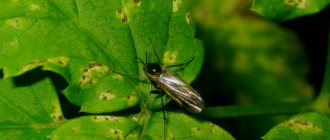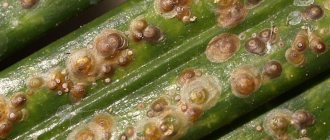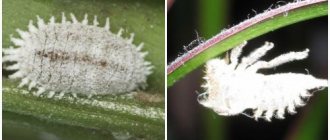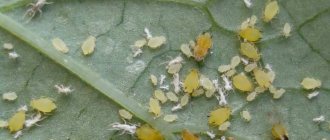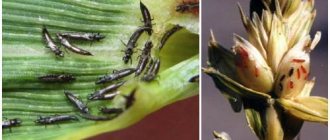Whitefly - everything you need to know
The whitefly is an insect from the aphid family. Causes serious damage to plants by sucking sap. It is not difficult to discover that the whitefly has settled on indoor plants (the photo will simplify the task) by itself and is actively laying eggs. To do this, just touch the infected crop - white small midges will surround it with a dense cloud.
Female whiteflies reproduce by laying eggs away from direct sunlight, preferably on the underside of leaves. The larvae cannot fly, so they spend most of their time motionless, gradually becoming covered with a white coating. Under the influence of the pest, parts of the plant change shape, lose color and fall off over time.
In addition, the insect is a carrier of infections.
The most vulnerable to whitefly are delicate indoor plants:
- roses;
- fuchsia;
- orchids;
- geraniums;
- primrose.
In indoor conditions, the insect is capable of infecting these plants throughout the year, flying from one to another around the apartment or house.
White midges on geraniums. A whitefly has appeared on the geranium.
About two months ago I noticed white spots on the leaves of the geranium, I thought something was missing, so I fed it. But after a while I noticed white flying midges on the leaves. At first I didn’t think anything of it, it was the first time I’d seen something like this. I read on the Internet that this is a whitefly. And she has already become a real nuisance. There is more and more of it. I followed advice from the Internet, but so far there is no result. Maybe someone has encountered this. I'd be glad for your advice.
| and get the opportunity to rate materials, communicate in comments and much more!')">and get the opportunity to rate materials, communicate in comments and much more!')"> |
Copy the code and paste it into the window for creating a post on LiveInternet, having first enabled the “Source” mode there.
Hacienda.ru → A whitefly appeared on the geranium.
Whitefly at home - reasons for its appearance
To understand how to get rid of whiteflies on indoor flowers, you should study the characteristics of the pests and start with the reasons for their appearance in the house. Understanding what prompted them to settle on flowers will help prevent future infestations.
As a rule, the main reasons for the appearance of dangerous white midges in an apartment are:
- Failure to comply with temperature and humidity conditions.
- Inability to ventilate the room.
- High plant density.
- Infection through newly acquired plants.
High plant density provokes the appearance of pests.
The dangerous whitefly, paradoxically, is also very gentle. It dies if the temperature drops below 15 degrees, and its subsequent appearance becomes impossible.
Signs of indoor plant infection
Whitefly infestation is visually detected by the following manifestations:
- the presence of larvae and laid eggs of the parasite on the underside of the leaves;
- a swarm of small butterflies that appear if you shake the flower a little;
- shiny sticky (waxy) coating on the leaves;
- spots of yellow, gray and black color, which indicate infection by pest eggs, and later by fungi;
- general deterioration in the appearance of the flora - yellowing of leaves, their curling, poor crop growth, signs of wilting.
If the listed symptoms appear, you should not only immediately isolate the affected plant, but also check the condition of neighboring bushes.
Creating optimal conditions for pest control
When deciding to fight whitefly on indoor flowers, you need to be prepared for the fact that the process will not be quick and simple. Insects can be removed in several stages, observing certain conditions to prepare for the “war”.
They start with quarantine for infected plants. To prevent the spread of the insect, infected plants are separated from healthy ones and placed in a room with the lowest possible temperature.
If we are talking about flowers that are unpretentious to the cold, such as fuchsia, then the most suitable place for it would be a window sill on an open balcony in late autumn or early winter, when the temperature reaches the desired level. A week will be enough for the white butterflies to die completely.
After the mass extermination of the pest by temperatures, the remains of eggs and traces of adult individuals are washed off with water, and the soil in the pot is replaced with new one. Damaged parts of the plant are removed in order to prevent the formation of putrefactive cells.
Below are several ways to combat whiteflies if the freezing method is not suitable for some reason. For greater efficiency and taking into account the latest generation of larvae covered with a wax shell, several methods will need to be combined to achieve results.
Getting rid of pests on fuchsia and other indoor plants
It is absolutely not necessary to be a qualified florist in order to independently create a home green corner by growing indoor flowers.
However, you should be guided by basic knowledge about plants: for example, what to do if midges appear, since, in addition to aesthetic pleasure, you can get some problems from house plants. Fuchsia fight against whitefly
Types of flower pests
There are two main types of insects that most often infect the leaves of geranium, pelargonium and fuchsia:
Black sciarid insects harm indoor plants
- sciarids are black insects;
- springtails are white midges.
Firstly, in order to establish the main cause of their occurrence, you need to understand what these indoor plant pests are.
Sciarids are dipterous, very small and barely noticeable insects that grow no more than 2 mm in length. As a rule, they can be gray and black. It is quite easy to notice insects, since these midges fly not only near the flower, but also spread throughout the living space.
Reproduction occurs by females laying eggs in moist soil. After a few days, larvae hatch, which subsequently cause enormous damage to the plant. Often, black midges breed in fuchsia.
Collembola white midges are dangerous for house plants
Springtails, or, in other words, springtails can be jumping or crawling insects. They are quite small in size and characterized by a white or grayish color. Their development and reproduction occurs in moist soil. Note that the larvae of these insects are capable of completely destroying the entire root system of plants.
As a rule, these midges most often appear in winter and spring. Springtails prefer to breed on pelargonium, orchid and geranium flowers. In addition, geraniums can harbor aphids, termites, and caterpillars.
The main causes of midges
Note that the causes of plant pests are quite commonplace. However, let's take a closer look at each of them:
Using tea leaves as fertilizer can attract midges to the plant
- Excessively moist soil. Perhaps this is one of the most important factors in the active reproduction of harmful insects. In the case when excess moisture stagnation forms in the pelargonium pot, the midges actively begin their activities.
- Initially contaminated soil. Please note that even at the stage of purchasing a flower in a pot, the soil may already be contaminated, of poor quality and requiring appropriate disinfection. In this case, it is quite difficult to determine the level of soil cleanliness, and in some situations it can be completely impossible.
- Midges can also enter a room through an open window. In addition, another way for insects to get into favorable conditions for development is through ventilation grilles or the most humid places in a living room.
- Pests can infest flowers that are fertilized with tea leaves, coffee solution, humus from leaves or other types of organic substances. As a rule, both sciarids and springtails will happily live in an environment created in this way.
Traditional methods of combating flower pests
Control methods at home
Today, there are a lot of folk methods of combating flower midges, the features of which are given below:
We place garlic on the surface of the soil from pests
- half a teaspoon of potassium permanganate and 2 tablespoons of baking soda must be added to ten liters of water. The resulting product is used as a watering for pelargonium for at least 2 weeks. At the same time, it is recommended to spray the leaves of the plant with warm water. This procedure is ideal for combating larvae located in the ground;
- Using a soap solution can also effectively combat midges. So, 100 grams of laundry soap must be dissolved in 0.5 liters of warm water. After this, use a soft sponge to gently wipe all parts of the indoor vegetation. In parallel with this, it is necessary to water the soil with a solution of potassium permanganate in order to simultaneously get rid of the larvae;
- if there are not very many midges, you can use sulfur.
Ordinary matches are inserted into the ground (heads down). Next, you should water the plants abundantly - this will help provoke a strong smell of sulfur, which will eventually repel insects from the pelargonium; Infusion of dry tobacco for spraying fuchsia - A good remedy is to use garlic cloves. Place them over the entire surface of the soil;
- spread out sprigs of dill with seeds and soil lightly sprinkled with red pepper will also help get rid of harmful insects;
- An effective remedy is an infusion of dry tobacco in the form of a spray solution. To do this, pour 50 grams of tobacco with 1 liter of water and leave to infuse for at least two days. After this, the resulting infusion should be filtered and another 1 liter of water should be added to it. Spraying is recommended to be carried out over several weeks.
Preventive measures
What can you do to prevent the occurrence of black and white midges on indoor plants in the future? We invite you to familiarize yourself with the main preventive methods:
- When buying pelargoniums in a store, you need to carefully examine the soil, as well as the plant itself, in order to exclude the presence of areas affected by parasites.
In addition, it is recommended to purchase an insecticidal substance for soil treatment. Proper care of plants will rid them of pests - It is important to pay attention to soil moisture, since watering the plant should be done only when the soil is completely dry.
- To prevent the root from rotting, it is necessary to ensure a regular supply of oxygen to the soil by loosening the soil.
- It is strictly not recommended to use human food as fertilizer. Today, ready-made fertilizers are available for sale, which are specifically used to fertilize indoor pelargonium.
- When replanting a flower, it is necessary to avoid using a substrate that contains rot and mold.
- An excellent agricultural technique is the addition of finely chopped coconut peel to the soil, which can be easily purchased at specialized flower shops.
Important! For vegetation that needs frequent and abundant watering, a layer of sand should be poured over the soil, which will then dry out much faster than the soil.
So, what is recommended for a gardener to do in order to ensure proper care of indoor plants: monitor the condition of the soil, strictly adhere to the regime of watering and fertilizing the plant, and also provide comfortable conditions for the growth and development of flowers.
A table for replanting plants will help avoid the appearance of harmful insects on plants
Only a systematic inspection of the home flora will prevent further spread of pests, thereby keeping the plants in proper condition.
Video: Caring for indoor Fuchsia plants
Physical impact on whiteflies - what does it come down to?
A proven remedy for whiteflies is mechanical traps. With their help, you can get rid of adult individuals capable of flying. You can make a trap with your own hands from scrap materials.
For a simple sample you will need small plywood sheets or sheets of cardboard. They must be painted in a color that attracts insects (white or yellow), lubricated with castor oil and a mixture of honey and rosin. Baits are placed near the insect habitat. For example, if they settled on fuchsia, then the bait is placed right there - on the windowsill.
As an option for a whitefly trap, simple fly tapes, fixed near the infected plants, are also suitable.
Our prevention tips:
- Protection against whiteflies begins with covering your windows and vents with mosquito nets.
- Do not place flower pots too close to each other, do not thicken your plantings.
- Do not allow water to stagnate in flower trays.
- Wash the leaves on both sides with a damp swab to remove dust and possible pests.
- Ventilate the room regularly.
- Don't overwater your flowers.
- Do not spray them in high ambient humidity.
- Strengthen the health and immunity of plants with the help of fertilizers and biostimulants (Epin, Zircon and others).
Chemicals against pests - which ones to choose?
If white midges on geraniums or fuchsias have proliferated so much that traps do not save the situation, it is worth moving on to more radical methods of control - using chemicals.
As mentioned above, a proven remedy against whiteflies is Aktara. It is used to treat the soil of plants infected with insects with accompanying spraying. You can increase the effectiveness of the drug by using it together with Actellik. Following the instructions, Actellik solution is used to spray indoor flowers.
A noticeable effect can be achieved by using Tanrek against the white pest. The result obtained in this case will last for at least three weeks, even at high temperatures.
Fitoverm has also proven itself well as a biological insecticide that is not capable of harming plants or humans. Along with it, benzyl benzoate emulsion, Fury, Mospilan, Intavir, Thiazipir and other drugs can be used.
For those who are going to use the drug Actellik or any of the above, the recommendation of adding shampoo or laundry soap to the solution may seem useful. In this case, the effect of the substances will be longer due to adhesion to the surface of the plants.
How to save pelargonium?
Ticks are not sensitive to all insecticides. For them, the industry has developed a special line: acaricides. These include the drugs Bitoxibacillin, Fitoverm, Akarin, Vertimek, Molniya, Fufanon, Kemifos, Karbofos-500, Ditox, Bi-58, Karate Zeon, Kungfu, Antiklesch, Iskra-M, Actellik, Omite, Thiovit Jet, Zolon, Oberon, Sunmite and others. It is useless to treat a plant against ticks with “ordinary” insecticides!
Attention! Many gardeners say that mites die quickly, but you need to be careful with medications. Firstly, they can be quite toxic (for example, Fufanon gives me a terrible headache. And both Fufanon and Actellik smell literally throughout the whole house!), and secondly, ticks quickly get used to the drug if you use it wrong.
Health to your plants!
Comments
I read and read and am frustrated that I didn’t figure it out myself, but how did you defeat them anyway? The most pleasant person has little of such poison in sensations. How can you save buns from such nasty things? Last year I lost so many varieties... You know, I wouldn’t even think that it was a mite. What drug helped, otherwise there are so many of them that I don’t know what to do with the choice, in the sense of what to choose, so that it will definitely help...
Thanks for the answer.
Hello Veronica. I poisoned the whole thing with phytoverm (at that time I couldn’t find anything stronger). It seemed to help, that is, there was no more such obvious brown drying out. But it is recommended to treat ticks three times with an interval of a week or 5 days. I fought with them almost all winter. I lost a bunch of varieties. I’m already thinking that I’ll give up buns. But with the rest, I’ll see how this winter goes. I am not 100% sure yet that I have found a solution to this problem.
